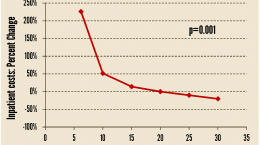Published on June 14, 2022
“An ounce of prevention is worth a pound of cure” — Benjamin Franklin
All eight of the chronic diseases reported to be the most expensive are associated with vitamin D
Key Points
- Vitamin D is associated with all eight of eight of the chronic diseases reported to be the most expensive
- Of the 30 leading causes of death reported in the United States in 2010, 19 are linked to low vitamin D status
- A veterans study found that patients who received one or more follow-up vitamin D tests had 50% lower inpatient laboratory and pharmacy costs, as compared to those that only received one test; almost 300% higher costs were seen among those who were vitamin D deficient and did not have follow-up testing, compared to those who were sufficient and who also followed up with a vitamin D test
 In the US, the CDC (2022) reports that “90% of the nation’s $4.1 trillion in annual healthcare expenditures are for people with chronic and mental health conditions.”
In the US, the CDC (2022) reports that “90% of the nation’s $4.1 trillion in annual healthcare expenditures are for people with chronic and mental health conditions.”
Vitamin D is associated with all eight of eight of the chronic diseases reported to be the most expensive; see below:
- Heart Disease and Stroke (cost the healthcare system $216 billion) (Benjamin et al., 2018)
- Cancer (Cancer care costs are expected to reach almost $240 billion by 2030) (Mariotto et al., 2020)
- Diabetes (Estimated medical and lost productivity cost of diagnosed diabetes in 2017 was $327 billion) (American Diabetes Association, 2018)
- Obesity (Costs $147 billion per year to the US healthcare system) (Finkelstein et al., 2009)
- Arthritis ($303.5 billion, which includes $140 for medical costs and $164 billion for indirect costs with lost wages) (Murphy et al., 2018)
- Alzheimer’s Disease ($305 billion for patient care and treatment) (Alzheimer’s Impact Movement and Alzheimer’s Association, 2020)
- Epilepsy ($8.6 billion in direct healthcare costs in 2016) (Dieleman et al., 2020)
- Tooth Decay ($45 billion in lost productivity) (Righolt et al., 2018)
Wow! Health Care Costs 39% Higher if Vitamin D Deficient, Finds Veterans Study
A 2008 study reported a retrospective chart analysis in a Veterans Affairs (VA) Hospital in the Southeastern United States. The study found that overall healthcare costs were 39% higher in veterans with vitamin D deficiency, as defined in this study by levels <20 ng/ml (50 nmol/L). Patients with vitamin D deficiency were found to have:
- more frequent clinic visits
- more frequent ER visits
- increased inpatient stay and inpatient services
For those patients with vitamin D test results, roughly 30-50% were vitamin D deficient on their initial test. The VA center with the lowest percentage of vitamin D deficiency also had more than 50% lower inpatient costs than the three centers with the highest rates of vitamin D deficiency. Also, patients who received one or more follow-up tests had 50% lower inpatient laboratory and pharmacy costs, as compared to those who only received one test (which gives the patient data required to maintain their optimal vitamin D level).
They compared patients who were (1) both deficient and never had a follow-up test, with (2) those who were only deficient or had no follow-up test, and (3) those who were both sufficient and had at least one follow-up test. The first group had 70% higher total inpatient costs than the second group, and almost 300% higher costs than the third group. Because of this finding, the study authors proposed that as a standard practice, vitamin D levels should be checked once or twice a year until they are stable at the desired level.
*Note: While the study used 20 ng/ml as their marker for vitamin D deficiency, the GrassrootsHealth panel of vitamin D scientists recommends the vitamin D level be a minimum of 40 ng/ml (100 nmol/L).
Different Diseases Require Different Optimal Vitamin D Levels for Prevention – Each Identified as Above 20 ng/ml
A review by Grant et al. defined optimal vitamin D levels necessary to help prevent certain diseases known to be major causes of death, based on a review of the strongest evidence published to date. The findings showed that optimal vitamin D levels needed for each outcome ranged from 25 ng/ml to 60 ng/ml – all of which were above the 20 ng/ml vitamin level. The study concluded that “…raising serum 25(OH)D concentrations to optimal concentrations will result in a significant reduction in preventable illness and death.”
How much additional cost could have been saved if the vitamin D deficiency cut-off was raised to 40 ng/ml? 60 ng/ml?
Vitamin D Researchers Agree: Addressing Vitamin D Deficiency is Cost-Effective, Preserving Healthcare Resources and Saving Lives
One of the many topics vitamin D scientists discussed in Baggerly et al. (2015) was the cost-effectiveness of addressing vitamin D deficiency in public health, estimating a reduction of direct costs in healthcare to be roughly $130 billion annually. “Of the 30 leading causes of death reported in the United States in 2010, 19 are linked to low vitamin D status…”
Take steps for your own health to ensure optimal vitamin D levels – for your family and loved ones as well – by measuring at home today.






